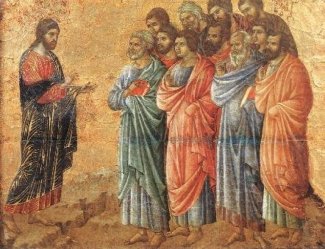At the beginning of the Sermon on the Mount Jesus issued a solemn warning in which he presented God’s law, given on Sinai during the first covenant, in light of the grace of the New Covenant:
Do not think that I have come to abolish the law or the prophets: I have come not to abolish but to fulfil. For truly I tell you, until heaven and earth pass away, not one letter, not one stroke of a letter, will pass from the law, until all is accomplished. Therefore, whoever breaks one of the least of these commandments, and teaches others to do the same, will be called least in the kingdom of heaven; but whoever does them and teaches them will be called great in the kingdom of heaven.329
Jesus, Israel’s Messiah and therefore the greatest in the kingdom of heaven, was to fulfil the Law by keeping it in its all embracing detail – according to his own words, down to “the least of these commandments”. He is in fact the only one who could keep it perfectly. On their own admission the Jews were never able to observe the Law in its entirety without violating the least of its precepts. This is why every year on the Day of Atonement the children of Israel ask God’s forgiveness for their transgressions of the Law. the Law indeed makes up one inseparable whole, and St. James recalls, “Whoever keeps the whole law but fails in one point has become guilty of all of it.”
This principle of integral observance of the Law not only in letter but in spirit was dear to the Pharisees. By giving Israel this principle they had led many Jews of Jesus’ time to an extreme religious zeal. This zeal, were it not to lapse into “hypocritical” casuistry, could only prepare the People for the unprecedented intervention of God through the perfect fulfilment of the Law by the only Righteous One in place of all sinners.
The perfect fulfilment of the Law could be the work of none but the divine legislator, born subject to the Law in the person of the Son. In Jesus, the Law no longer appears engraved on tables of stone but “upon the heart” of the Servant who becomes “a covenant to the people”, because he will “faithfully bring forth justice”. Jesus fulfils the Law to the point of taking upon himself “the curse of the Law” incurred by those who do not “abide by the things written in the book of the Law, and do them”, for his death took place to redeem them “from the transgressions under the first covenant”.
The Jewish people and their spiritual leaders viewed Jesus as a rabbi. He often argued within the framework of rabbinical interpretation of the Law. Yet Jesus could not help but offend the teachers of the Law, for he was not content to propose his interpretation alongside theirs but taught the people “as one who had authority, and not as their scribes”.In Jesus, the same Word of God that had resounded on Mount Sinai to give the written Law to Moses, made itself heard anew on the Mount of the Beatitudes. Jesus did not abolish the Law but fulfilled it by giving its ultimate interpretation in a divine way: “You have heard that it was said to the men of old. . . But I say to you. . .” With this same divine authority, he disavowed certain human traditions of the Pharisees that were “making void the word of God”.
Going even further, Jesus perfects the dietary law, so important in Jewish daily life, by revealing its pedagogical meaning through a divine interpretation: “Whatever goes into a man from outside cannot defile him. . . (Thus he declared all foods clean.). . . What comes out of a man is what defiles a man. For from within, out of the heart of man, come evil thoughts. . .” In presenting with divine authority the definitive interpretation of the Law, Jesus found himself confronted by certain teachers of the Law who did not accept his interpretation of the Law, guaranteed though it was by the divine signs that accompanied it. This was the case especially with the sabbath laws, for he recalls, often with rabbinical arguments, that the sabbath rest is not violated by serving God and neighbour, which his own healings did.
From the Catechism of the Catholic Church 577-582


This is a beautiful icon!
Thank you so much ! God bless!